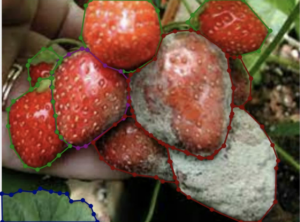Progress report for GS22-271
Project Information
The objective of the research is to build an energy-efficient autonomous UVC robotics platform for strawberry fungal management. The proposed autonomous robotics platform is expected to enable non-chemical fungal treatment thus sustainable organic strawberry farming. Crucially, our research will address the critical challenges faced by strawberry growers when using UVC for fungal management.
The major challenge of the conventional UVC solution is the low energy efficiency thus poor affordability for strawberry farmers. We will use UVC LED known 95% more energy efficient than the UVC lamp to improve the energy efficiency of the system [1]. We will further optimize the distance between the UVC LED and strawberry plant to increase energy efficiency. Our research proposes a smart LED light intensity computation method to precisely control its individual UVC LED for smart energy-efficient fungal management.
Another major challenge of the conventional UVC fungal treatment solution is UVC safety. UVC poses significant radiation risks to human skin and eyes. Our research proposes a smart grower detection method thus to protect growers from harmful UVC radiation to improve the adoption of the technology.
The autonomous robotics platform is affordable to strawberry growers, especially for socially disadvantaged farmers. The user-friendliness features of the platform enable socially disadvantaged farmers to use the platform for organic strawberry fungal management.
Goal 1: Energy-efficient UVC Platform Development. Novel high throughput close proximity UVC source will be developed for effective fungal management. With the solution, the energy-efficient UVC LED will be used, which is 80 - 95% more energy efficient than the UVC lamp [1]. Furthermore, we will also shorten the distance between the light source and the plant to increase energy efficiency. In contrast to the UVC lamp, the UVC LED source is miniature in size therefore it is able to be used in close proximity to the plant. The intensity of each individual LED will also be controlled based on the severeness of fungal for precise control of fungal diseases.
Goal 2: Smart Fungal Recognition and Analysis Pipeline Development. The importance of big data and artificial intelligence in sustainable agriculture has been well demonstrated [23, 24]. For this, we will build a smart data analysis pipeline for autonomous fungal disease recognition in order to precisely deliver UVC radiation to each individual plant. Specifically, modern deep learning computer vision algorithms will be built for the precise detection of fungal diseases to determine the needed dose for the treatment of fungal diseases. We will also develop a user-friendly GUI application for reporting the results of the UVC fungal treatment.
Goal 3: Affordable and Safe Robotics Platform Development. In particular, we will build an affordable robotics platform for small to medium-sized farms and socially disadvantaged farmers to enable them to better implement sustainable strawberry fungal control. The proposed platform will cost about 5,000$, making it affordable to the majority of strawberry growers. The autonomous robotics platform will make the UVC handling safe for strawberry growers. The UVC chamber will be equipped with infrared cameras to detect the presence of growers. Human detection computer vision algorithms will be developed to detect growers with high accuracy. The UVC light will be automatically turned off upon the detection of the growers close to the UVC chamber to ensure UVC safety.
Cooperators
- (Researcher)
- (Researcher)
- (Researcher)
Research
It's a great honor to have support from the Southern SARE. We have been working very closely on the supported research. The research has the following goals. First, we want to develop an optical source for strawberry fungal control. Second, we want to develop a robotics platform able to perform automated strawberry fungal control. Third, we want to develop the strawberry recognition method to recognize the strawberry fungal.
Goal 1
For the first objective, we have been working closely on the development of a new UVC source for mold removal. The new UVC source is designed on the PCB circuit board. The degin goal is able to arrange the UVC LED diodes to reach the desired power. We also use Infineon constant current driver to provide a constant current to the board. With the constant current driver, we will be able to control the UVC LED intensity and duration.
The UVC PCB board is still in development, our plan is to scale it to a larger scale to a 10 by 10 inch design. With such design, we are able to cover the entire row of the strawberry. It is expected that the UVC LED will last about 40,000 hours of usage. The new UVC panel will also feature an AI camera to automatically detect and recognize the strawberry fungal.
Goal 2
The second goal of the research is to develop a robotics platform to apply the UVC source for fungal control. For this purpose, we have developed a new robotics platform for strawberry mold removal. The new robotics platform consists of a smart robot and a trailer. The robot is designed to travel on off-road terrains. It is designed to tow over 100 pounds weight. Hence it can be used for the actual farming environment. The robotics platform features two cameras. One is for near-distance imaging and another is for far-distance imaging. Combining the two cameras is able to yield both near and far imaging functions thus for the best outcomes of detection of the strawberry mold. The robot also features a GPS sensor. Based on this, it is able to navigate in the farm environment based on the GPS map shown in Figure 1.
Figure 1: The robotics platform with a payload of about 100 pounds.
Goal 3
The third goal of the research is to develop the strawberry mold detection method. For this purpose, we have been collecting healthy strawberry images and gray mold strawberry images. Among them, 150 healthy strawberries and 300 gray mold images were collected. We are working on using computer vision technology to detect the gray mold on strawberries. At present, the images have been labeled, and the initial strawberry mold image detection has been performed.
The evaluation of the robotics platform has been conducted on the MTSU research farm. Various tests have been performed for this purpose. Among them, it includes the test on the grassland and the test on the research plots.
Optical Source Development
The UVC-based optical source has been developed. We performed the initial test of the optical source. We have also tested the UVC lamp. Our objective is to try to publish a paper to contrast the effectiveness of the UVC LED panel and conventional UVC lamp for their effectiveness in strawberry mold removal. Evidently, in contrast to UVC lamps, the UVC LED panel is more capable of being close to the strawberry mold. It is known that the UVC radiation energy is inversely proportional to the square of the distance from the UVC source [1]. As such, it is expected that the UVC LED panel will be more effective than the UVC lamps. The specs of the UVC LED panel are shown in Table 1.
Table 1: The UVC LED panel spec
| LED | Voltage (V) | Current (A) | Power (W) | # Used | Total Power (W) |
| UVC (270- 280nm) | 6.17 | 0.5 | 3.085 | 12 | 37.02 |
The UVC LED panel is designed to be chained together. In reality, it is expected that five or six such panels can be easily chained together to construct 10 by 10 inches or larger panels to perform UVC radiation on strawberries. The single fabricated UVC LED panel (37.2W) is shown in Figure 2.
Figure 2: The fabricated UVC LED panel on a PCB.
MTSU farm Evaluation
We have also tested the robotics platform on the MTSU research farm. Different scenarios of the tests have been performed. It includes the robot navigation on the grassland as well as the navigation on the research plots. In the following, we showed a few videos for the navigation process. The test includes the robot navigation on the MTSU research farm plots.
The test also includes the robot traveling on the grassland
https://youtube.com/shorts/nmivAYTF8Z0
The critical step in the detection of gray mold is the building of the strawberry fungal database. Until present, there is very little presence of the gray mold database. As such, in order to perform precise gray mold detection, we have started the database construction. The database involves the collection of a sufficiently large amount of data from online to make such database. The total of images collected is 300 gray mold images and 150 healthy images at present. We will use segment anything model pre-trained model [2], therefore it will reduce the required number of images.
For the construction of the database, the gray mold images are first compared with the standard database and confirmed its gray mold before downloading. After confirmation, the gray mold images will be downloaded. Similarly, healthy strawberry images were also confirmed before downloading them online. Subsequently, the strawberry database will be labeled. Labelme software is used to label the images. In contrast to class-only-based labeling, detailed segmentation-based labeling is used shown in Figure 3.
Figure 3: The labeled strawberry
In contrast to the conventional recognition of the strawberry, the new labeling contains sufficient details of each part of the image.
For example, we have clearly labeled the leaves, the fruit, the healthy fruit, and the fruit with gray mold.
We are still working on the segment anything model to perform precise recognition [2]. More results will be updated in the next report.
[1] T. Okuno, J. Ojima, H. Saito, Ultraviolet radiation emitted by co2 arc welding, Annals
of Occupational Hygiene 45 (2001) 597–601.
[2] A. Kirillov, E. Mintun, N. Ravi, H. Mao, C. Rolland, L. Gustafson, T. Xiao, S. Whitehead,
A. C. Berg, W.-Y. Lo, et al., Segment anything, arXiv preprint arXiv:2304.02643
(2023).
Educational & Outreach Activities
Participation Summary:
We have involved multiple undergraduate students in this project. They participated in the UVC LED production, robotics platform development, and the strawberry recognition process. They all feel that they have learned a lot through the process. Ibrahim Aljilani got an internship position because he has worked on this research.
Project Outcomes
The project will have a significant impact on sustainability. It will reduce or even eliminate the use of fungicides thus important for sustainability.
The significant advantages of the method are that it does not need a fungicide.
The problem with the UVC approach is that it does need electricity. In practice, the deployment of solar panels can address the electricity problem.
In this research. We have gained the following knowledge.
(1) We have built a robotics platform. The robotics platform is able to travel in an off-road farming environment.
(2) We have built UVC LED panel. The UVC LED panel can be chained together to make a large-scale UVC LED panel.
(3) We have started the strawberry fungal recognition. The model is expected to differentiate different molds, healthy strawberries, and leaves among others.
(4) We are about to start the farm outreaches.
The recommendation of the future SARE study is to build a bridge between undergraduate and graduate students to speed up the project to impact farmers.
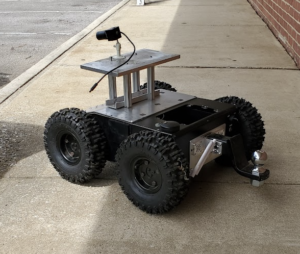
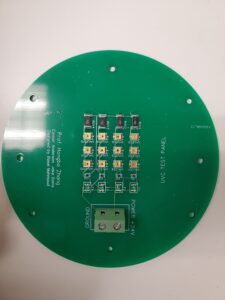
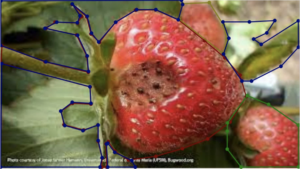
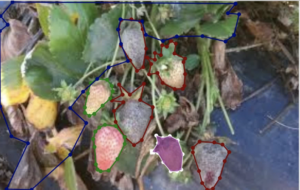 .
. 